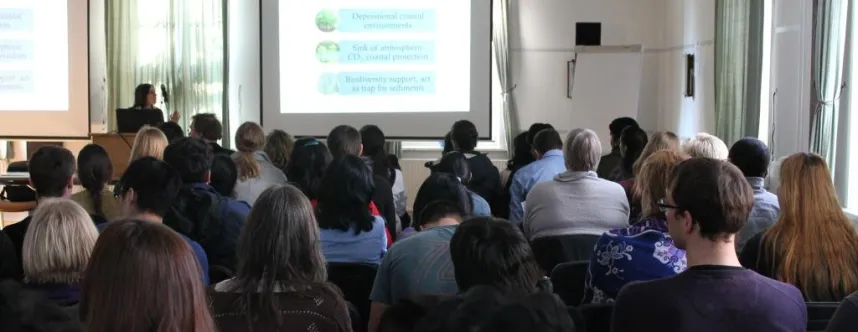MOLIFE RESEARCH SEMINAR Dr. Gerhard Hummer
Molecular simulation of protein dynamics and function
We use molecular simulations to study functional protein dynamics over a broad range of time scales. Quantum-mechanics/molecular mechanics (QM/MM) descriptions allow us to follow fast, photoexcitation-driven protein motions on the picosecond scale [1]. The resulting simulation trajectories are compared directly to femtosecond time-resolved protein crystallography experiments at X-ray free electron lasers. To study the functional dynamics in molecular motors and pumps [2] on the nano- to millisecond time scales, we have used classical and QM/MM simulations [3-6]. In nonequilibrium simulations, we drive these biomolecular machines by applying mechanical bias and inducing redox transitions that mimic their operation in a biological setting. The simulations help elucidate the molecular mechanisms underlying the efficient energy transduction processes in FoF1-ATP synthase [3-4] and the proton pump complex I [5-6].
T.R.M. Barends et al., “Direct observation of ultrafast collective motions in CO myoglobin upon ligand dissociation,” Science, in press (2015). [https://www.sciencemag.org/content/early/2015/09/09/science.aac5492.short]
M. Wikström, V. Sharma, V.R.I. Kaila, J. Hosler, G. Hummer, “New perspectives on proton pumping in cellular respiration,” Chemical Reviews 115, 2196-2221 (2015). [http://dx.doi.org/10.1021/cr500448t]
K.-I. Okazaki, G. Hummer, “Elasticity, friction, and pathway of γ-subunit rotation in FoF1-ATP synthase,” Proc. Natl. Acad. Sci. U.S.A. 112, 10720-10725 (2015). [http://dx.doi.org/10.1073/pnas.1500691112]
K.-I. Okazaki, G. Hummer, “Phosphate release coupled to rotary motion of F1-ATPase,” Proc. Natl. Acad. Sci. USA 110, 16468-73 (2013).
V. Sharma, G. Belevich, A.P. Gamiz-Hernandez, T. Róga, I. Vattulainen, M. Verkhovskaya, M. Wikström, G. Hummer, V.R.I. Kaila, “Redox-induced activation of the proton pump in the respiratory complex I”, Proc. Natl. Acad. Sci. U.S.A. 112, 11571-11576 (2015). [http://dx.doi.org/10.1073/pnas.1503761112]
V. R. I. Kaila, M. Wikström, G. Hummer, “Electrostatics, hydration, and proton transfer dynamics in the membrane domain of respiratory complex I,” Proc. Natl. Acad. Sci. USA 111, 6988–6993 (2014).
Further Info:
Speaker: Dr. Gerhard Hummer, Max Planck Institute of Biophysics, Franktfurt, Germany
Host: Prof. Dr. Ulrich Kleinekathöfer, Professor of Theoretical Physics, Focus Area: Health - Physics & Earth Sciences, Email: u.kleinekathoefer@jacobs-university.de, Tel: +49 421 200-3523, Link to Homepage: http://www.jacobs-university.de/ses/ukleinekathoefer
Event details and reservation
10.11.2015
Dr. Gerhard Hummer Ulrich Kleinekathöfe
Max Planck Institute of Biophysics, Franktfurt, Germany
Molecular simulation of protein dynamics and function
We use molecular simulations to study functional protein dynamics over a broad range of time scales. Quantum-mechanics/molecular mechanics (QM/MM) descriptions allow us to follow fast, photoexcitation-driven protein motions on the picosecond scale [1]. The resulting simulation trajectories are compared directly to femtosecond time-resolved protein crystallography experiments at X-ray free electron lasers. To study the functional dynamics in molecular motors and pumps [2] on the nano- to millisecond time scales, we have used classical and QM/MM simulations [3-6]. In nonequilibrium simulations, we drive these biomolecular machines by applying mechanical bias and inducing redox transitions that mimic their operation in a biological setting. The simulations help elucidate the molecular mechanisms underlying the efficient energy transduction processes in FoF1-ATP synthase [3-4] and the proton pump complex I [5-6].
Dr. Gerhard Hummer Ulrich Kleinekathöfe
Max Planck Institute of Biophysics, Franktfurt, Germany
Molecular simulation of protein dynamics and function
We use molecular simulations to study functional protein dynamics over a broad range of time scales. Quantum-mechanics/molecular mechanics (QM/MM) descriptions allow us to follow fast, photoexcitation-driven protein motions on the picosecond scale [1]. The resulting simulation trajectories are compared directly to femtosecond time-resolved protein crystallography experiments at X-ray free electron lasers. To study the functional dynamics in molecular motors and pumps [2] on the nano- to millisecond time scales, we have used classical and QM/MM simulations [3-6]. In nonequilibrium simulations, we drive these biomolecular machines by applying mechanical bias and inducing redox transitions that mimic their operation in a biological setting. The simulations help elucidate the molecular mechanisms underlying the efficient energy transduction processes in FoF1-ATP synthase [3-4] and the proton pump complex I [5-6].
Date
Location
Jacobs University Bremen, Lecture Hall of Research II
